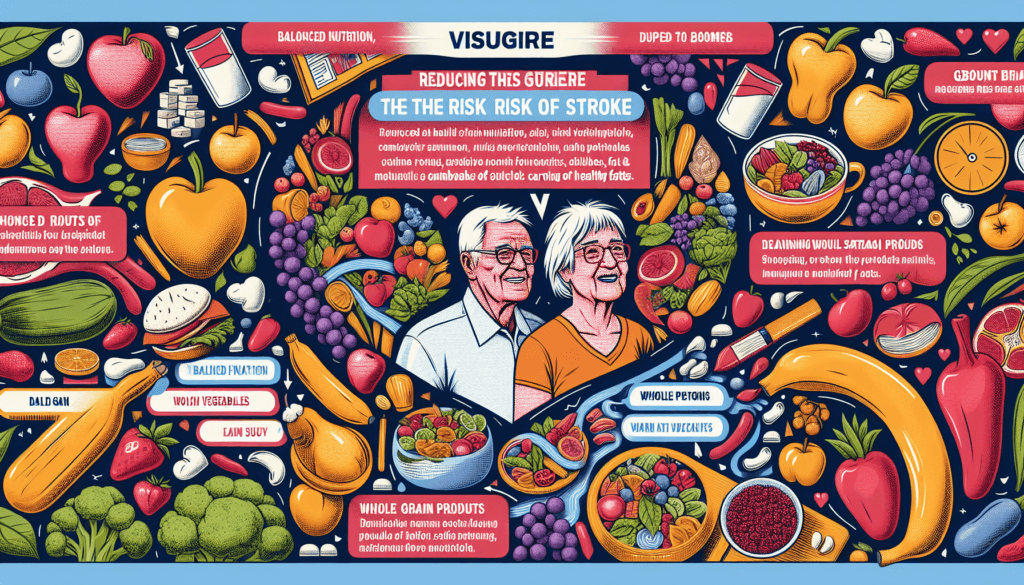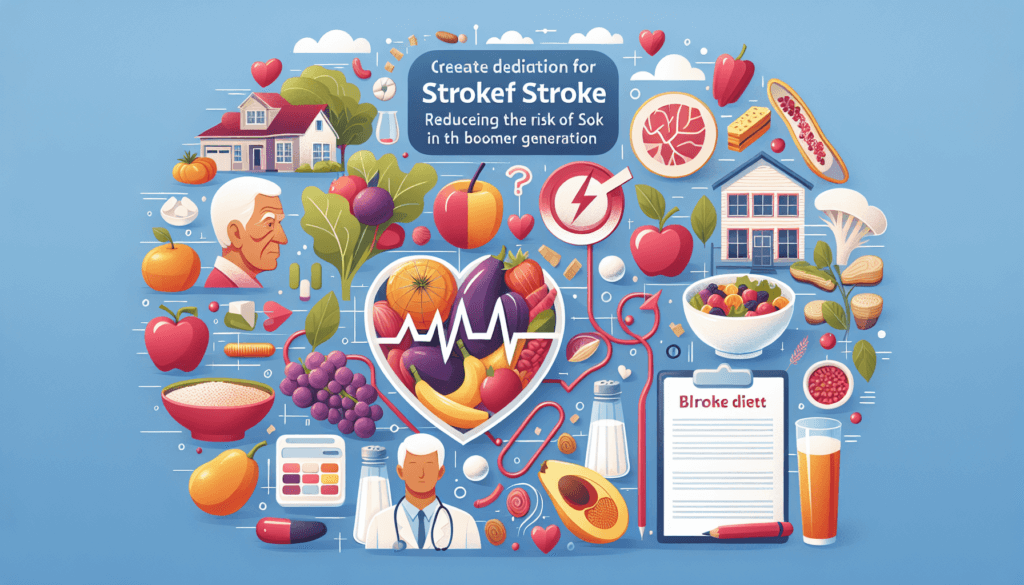If you’re a boomer concerned about reducing the risk of stroke, then making simple changes to your diet could be the answer you’re looking for. By adopting a heart-healthy eating plan, you can take proactive steps towards safeguarding your health and well-being. In this article, we’ll explore some dietary tips and strategies specifically tailored to boomers, helping you understand how certain food choices can contribute to a reduced risk of stroke. So, let’s get started on this journey towards a healthier you!

Understanding Stroke
What is a stroke?
A stroke, also known as a cerebrovascular accident (CVA), occurs when the blood flow to the brain is disrupted. This can happen due to a blockage or rupture of a blood vessel, leading to inadequate oxygen and nutrient supply to the brain cells. When the brain doesn’t receive enough blood, it can result in the death of brain cells and permanent damage to the affected area. Strokes can have serious implications on a person’s physical and cognitive abilities, making it important to understand the causes, types, and risk factors.
Types of stroke
There are two primary types of strokes: ischemic stroke and hemorrhagic stroke.
Ischemic stroke: This is the most common type of stroke, accounting for about 85% of all cases. It occurs when a blood vessel supplying the brain becomes blocked due to a blood clot or fatty deposits, restricting the blood flow. Ischemic strokes can be further classified into thrombotic strokes (caused by a blood clot forming within a blood vessel in the brain) and embolic strokes (caused by a blood clot that originates elsewhere in the body and travels to the brain).
Hemorrhagic stroke: This type of stroke occurs when a blood vessel in the brain ruptures or leaks, leading to bleeding in or around the brain. Hemorrhagic strokes are less common but often more severe than ischemic strokes.
Causes and risk factors
Several factors can contribute to the risk of stroke. Some risk factors, such as age, gender, and family history, cannot be modified. However, other risk factors can be controlled or managed through lifestyle modifications. These include:
- High blood pressure: Uncontrolled high blood pressure is one of the major risk factors for stroke. It can damage the blood vessels over time, making them prone to ruptures or blockages.
- Smoking: Cigarette smoking increases the risk of stroke by damaging the blood vessels and promoting the formation of blood clots.
- High cholesterol levels: High levels of low-density lipoprotein (LDL) cholesterol, often referred to as “bad” cholesterol, can contribute to the development of plaque in the blood vessels, narrowing them and increasing the risk of stroke.
- Diabetes: Poorly controlled diabetes can damage blood vessels and increase the risk of stroke.
- Obesity: Being overweight or obese can increase the risk of various health conditions, including high blood pressure, high cholesterol, and diabetes, all of which can contribute to stroke risk.
- Sedentary lifestyle: Lack of physical activity and a sedentary lifestyle can contribute to obesity, high blood pressure, and other risk factors for stroke.
- Excessive alcohol consumption: Heavy alcohol consumption can raise blood pressure and contribute to the development of cardiovascular diseases, increasing the risk of stroke.
The Role of Diet in Stroke Prevention
The link between diet and stroke risk
Diet plays a crucial role in maintaining overall health and reducing the risk of various diseases, including stroke. Research has shown that certain dietary choices can significantly impact the risk of stroke. A healthy diet can help manage risk factors such as high blood pressure, high cholesterol levels, and obesity, all of which contribute to stroke risk.
Key nutrients for stroke prevention
Incorporating specific nutrients into your diet can help reduce the risk of stroke. Here are some key nutrients to focus on:
Potassium: Consuming foods rich in potassium can help lower blood pressure, a major risk factor for stroke. Potassium-rich foods include bananas, oranges, spinach, and sweet potatoes.
Omega-3 fatty acids: These healthy fats have been shown to support heart health and reduce the risk of stroke. Sources of omega-3 fatty acids include fatty fish like salmon and trout, as well as walnuts and flaxseeds.
Fiber: A diet high in fiber can help lower cholesterol levels and promote healthy digestion. Whole grains, fruits, vegetables, and legumes are excellent sources of dietary fiber.
Antioxidants: Foods rich in antioxidants, such as berries, spinach, and dark chocolate, can help protect against oxidative stress and inflammation, both of which can contribute to stroke risk.
Foods to avoid for reducing stroke risk
Certain foods should be limited or avoided to reduce the risk of stroke:
High-sodium foods: Excessive sodium intake can raise blood pressure, increasing the risk of stroke. Processed foods, fast food, and canned soups are often high in sodium and should be consumed sparingly.
Trans fats: Trans fats raise LDL cholesterol levels and increase the risk of cardiovascular diseases, including stroke. Foods containing trans fats include fried foods, baked goods, and some margarine products.
Sugary beverages: Consuming sugary drinks, such as soda and fruit juices, regularly has been associated with an increased risk of stroke. Opting for water, herbal tea, or freshly squeezed juices can help reduce sugar intake.
Choosing a Heart-Healthy Diet
The importance of a heart-healthy diet
A heart-healthy diet not only promotes cardiovascular health but also helps reduce the risk of stroke. By focusing on nutritious foods and making smart dietary choices, you can positively impact your heart health and overall well-being.
Dietary guidelines for stroke prevention
To reduce the risk of stroke, it is recommended to adhere to the following dietary guidelines:
- Opt for a balanced diet that includes a variety of fruits, vegetables, whole grains, lean proteins, and healthy fats.
- Limit the consumption of saturated fats and trans fats, as they can raise cholesterol levels.
- Choose lean sources of protein, such as poultry, fish, beans, and legumes, instead of red meat.
- Limit the consumption of processed and refined foods, which are often high in added sugars and unhealthy fats.
- Pay attention to portion sizes to avoid overeating and maintain a healthy weight.
- Stay hydrated by drinking an adequate amount of water throughout the day.
The Mediterranean diet
The Mediterranean diet has been extensively studied for its health benefits, including its protective effects against stroke. This eating pattern emphasizes fruits, vegetables, whole grains, legumes, nuts, seeds, olive oil, and moderate consumption of fish, poultry, and dairy products. It limits the intake of red meat, processed foods, and added sugars, while encouraging regular physical activity. The Mediterranean diet’s emphasis on plant-based foods, healthy fats, and moderation makes it a suitable choice for stroke prevention.
The DASH diet
The Dietary Approaches to Stop Hypertension (DASH) diet is another eating plan that has been shown to lower blood pressure and reduce the risk of stroke. The DASH diet emphasizes fruits, vegetables, whole grains, lean proteins, and low-fat dairy products while limiting sodium, saturated fats, and added sugars. By following the DASH diet, you can help manage blood pressure levels and promote overall cardiovascular health.
Plant-based diets
Plant-based diets, such as vegetarian or vegan diets, can also reduce the risk of stroke. These diets focus on a variety of plant foods, such as fruits, vegetables, whole grains, legumes, nuts, and seeds, while excluding or minimizing animal products. Plant-based diets are naturally low in saturated fats and cholesterol, which can contribute to better heart health and stroke prevention.
Reducing Salt Intake
The impact of excessive sodium
Excessive sodium intake can lead to fluid retention and raise blood pressure levels, increasing the risk of stroke. The majority of sodium in our diet comes from processed and restaurant foods, rather than from salt added during cooking or at the table.
Recommended salt intake
The American Heart Association recommends limiting sodium intake to no more than 2,300 milligrams (mg) per day, with an ideal goal of 1,500 mg per day for most adults. However, for individuals with high blood pressure, diabetes, or kidney disease, it is advisable to limit sodium intake to 1,500 mg per day.
Tips for reducing salt in the diet
Reducing salt intake can be challenging, as many processed and packaged foods contain high amounts of sodium. However, with mindful choices and small changes in dietary habits, it is possible to lower sodium consumption. Here are some tips to reduce salt intake:
- Read food labels and choose low-sodium or sodium-free options whenever possible.
- Cook meals at home using fresh ingredients, rather than relying on pre-packaged foods that are typically high in sodium.
- Use herbs, spices, vinegar, and lemon juice to flavor dishes instead of relying on salt.
- Rinse canned foods, such as beans or vegetables, under water before consuming to reduce sodium content.
- Limit the use of condiments that are high in sodium, such as soy sauce, ketchup, and salad dressings.

Optimizing Potassium Intake
The role of potassium in stroke prevention
Consuming an adequate amount of potassium as part of a balanced diet can help regulate blood pressure and reduce the risk of stroke. Potassium counteracts the effects of sodium on blood pressure, promoting healthy blood vessel function.
High-potassium foods
To increase potassium intake, incorporate these high-potassium foods into your diet:
- Fruits: Bananas, oranges, avocados, cantaloupes, and kiwis.
- Vegetables: Spinach, sweet potatoes, tomatoes, mushrooms, and Brussels sprouts.
- Legumes: Black beans, lentils, chickpeas, and kidney beans.
- Nuts and seeds: Almonds, pistachios, pumpkin seeds, and chia seeds.
- Fish: Salmon, tuna, and mackerel.
Incorporating more potassium-rich foods in the diet
To optimize potassium intake, consider the following strategies:
- Include a variety of fruits and vegetables in your meals and snacks.
- Have a potassium-rich food at every meal.
- Prepare homemade meals using fresh ingredients instead of relying on processed foods.
- Experiment with new recipes that incorporate potassium-rich foods.
- Use potassium-rich foods as side dishes or toppings to increase their consumption.
Maintaining Healthy Cholesterol Levels
Understanding cholesterol and stroke risk
High cholesterol levels, particularly elevated levels of LDL cholesterol, increase the risk of stroke. LDL cholesterol can accumulate in the blood vessels and lead to the formation of plaque, narrowing the arteries and potentially causing blockages.
Foods to include for healthy cholesterol levels
Incorporate the following foods into your diet to help maintain healthy cholesterol levels and reduce the risk of stroke:
- Healthy fats: Olive oil, avocados, nuts, and seeds contain monounsaturated and polyunsaturated fats, which can help lower LDL cholesterol levels.
- Omega-3 fatty acids: Fatty fish like salmon and trout, as well as walnuts and flaxseeds, are rich in omega-3 fatty acids, which have been shown to support heart health and reduce cholesterol levels.
- Soluble fiber: Foods like oats, barley, legumes, and fruits (e.g., apples, citrus fruits) contain soluble fiber, which can help lower LDL cholesterol levels.
Foods to avoid for high cholesterol
To reduce cholesterol levels and minimize the risk of stroke, limit or avoid the following foods:
- Foods high in saturated fats: Butter, fatty meats, full-fat dairy products, and coconut oil contain high amounts of saturated fats, which can raise LDL cholesterol levels.
- Trans fats: Fried foods, baked goods, and some margarine products often contain trans fats, which raise LDL cholesterol levels and increase the risk of cardiovascular diseases.

Balancing Omega-3 and Omega-6 Fatty Acids
The importance of a balanced ratio
Both omega-3 and omega-6 fatty acids are essential fats that the body needs for proper functioning. However, maintaining a balanced ratio between these two types of fatty acids is crucial for heart health and stroke prevention. In Western diets, the ratio of omega-6 to omega-3 tends to be too high due to the excessive consumption of processed and fried foods.
Foods rich in omega-3 fatty acids
To achieve a balanced ratio, include these foods rich in omega-3 fatty acids in your diet:
- Fatty fish: Salmon, mackerel, sardines, trout, and herring.
- Flaxseeds and chia seeds: These seeds are packed with omega-3 fatty acids and can be easily added to smoothies, yogurt, or oatmeal.
- Walnuts: Walnuts are not only a good source of omega-3 fatty acids but also provide beneficial antioxidants and fiber.
Limiting omega-6 intake
While omega-6 fatty acids are necessary for the body, it’s important to limit their intake to maintain a healthy balance. To reduce omega-6 intake, follow these tips:
- Minimize the consumption of processed and fried foods, as they often contain high amounts of omega-6 fatty acids.
- Choose cooking oils with a more balanced ratio of omega-6 to omega-3, such as olive oil or avocado oil.
- Read food labels and avoid products that contain processed vegetable oils, such as corn oil or soybean oil.
Including Fiber in the Diet
The benefits of dietary fiber
Fiber is an essential component of a heart-healthy diet and can help reduce the risk of stroke. Dietary fiber offers a range of benefits, including:
- Lowering LDL cholesterol levels: Soluble fiber binds to cholesterol in the digestive system, preventing its absorption and promoting its excretion.
- Regulating blood sugar levels: Fiber slows down the absorption of sugar, preventing spikes in blood sugar levels and promoting better glycemic control.
- Promoting healthy digestion: Fiber adds bulk to the stool, preventing constipation and promoting regular bowel movements.
Fiber-rich foods for stroke prevention
To increase your fiber intake and reduce the risk of stroke, include these fiber-rich foods in your diet:
- Whole grains: Opt for whole grain products such as whole wheat bread, brown rice, quinoa, and oats.
- Fruits and vegetables: Choose a variety of colorful fruits and vegetables, as they are often excellent sources of dietary fiber.
- Legumes: Beans, lentils, and chickpeas are high in fiber, protein, and other essential nutrients.
- Nuts and seeds: Almonds, chia seeds, flaxseeds, and sunflower seeds provide a good amount of fiber and healthy fats.
Tips for increasing fiber intake
To incorporate more fiber into your diet, try the following strategies:
- Start your day with a high-fiber breakfast, such as oatmeal topped with fruits and nuts.
- Snack on fruits, vegetables, or nuts instead of processed snacks or desserts.
- Cook homemade meals using whole grain ingredients, such as whole wheat pasta or brown rice.
- Gradually increase your fiber intake to allow your digestive system to adjust, and drink plenty of water to prevent constipation.

Monitoring Blood Pressure
The link between high blood pressure and stroke
High blood pressure, also known as hypertension, is a significant risk factor for stroke. When blood pressure is consistently elevated, it can damage the blood vessels and make them prone to ruptures or blockages. Monitoring and managing blood pressure levels are vital for stroke prevention.
Dietary strategies for managing blood pressure
Adopting healthy eating habits can help manage blood pressure and reduce the risk of stroke. Here are some dietary strategies to consider:
- Reduce sodium intake: Limit the consumption of high-sodium foods and opt for low-sodium options whenever possible.
- Increase potassium intake: Consuming potassium-rich foods, such as bananas, spinach, and sweet potatoes, can help lower blood pressure.
- Emphasize fruits and vegetables: These natural, whole foods provide essential nutrients and fiber while being low in sodium and fat.
- Limit alcohol consumption: Excessive alcohol intake can raise blood pressure levels. Aim to moderate alcohol consumption or avoid it altogether.
- Maintain a healthy weight: Obesity and excess weight can contribute to high blood pressure. Regular exercise and a balanced diet can help maintain a healthy weight.
The DASH diet and blood pressure control
The DASH diet, previously mentioned for its role in stroke prevention, is specifically designed to lower blood pressure. By following the DASH diet, individuals can reduce their sodium intake and increase their intake of potassium, fiber, and other beneficial nutrients. This eating pattern, combined with regular physical activity, can effectively manage blood pressure and reduce the risk of stroke.
Tips for Healthy Eating
Staying hydrated
Proper hydration is essential for maintaining overall health and preventing dehydration, which can lead to various health problems, including stroke. Aim to drink an adequate amount of water throughout the day, especially during hot weather or physical activity.
Choosing whole, unprocessed foods
Processed and packaged foods often contain high amounts of sodium, unhealthy fats, and added sugars, making them detrimental to heart health and stroke prevention. Opt for whole, unprocessed foods as much as possible, as they are generally lower in sodium, healthier fats, and added sugars.
Limiting alcohol consumption
Excessive alcohol consumption can raise blood pressure levels and contribute to the development of cardiovascular diseases, including stroke. To reduce the risk of stroke, it is advisable to moderate alcohol consumption or avoid it altogether. If you choose to drink alcohol, do so in moderation, which means up to one drink per day for women and up to two drinks per day for men.
Managing portion sizes
Controlling portion sizes is essential for maintaining a healthy weight and preventing obesity, which is a risk factor for stroke. Be mindful of serving sizes and avoid overeating. Pay attention to hunger and fullness cues while eating and eat slowly to allow your body to register satiety. Listen to your body’s natural signals and try to avoid using food as an emotional crutch.
In conclusion, boomers can reduce the risk of stroke through diet by making healthy choices and incorporating key nutrients into their meals. By following a heart-healthy diet, reducing salt intake, optimizing potassium levels, maintaining healthy cholesterol levels, balancing omega-3 and omega-6 fatty acids, including fiber in the diet, monitoring blood pressure, and following general healthy eating tips, boomers can take proactive steps towards stroke prevention. Remember, small changes in dietary habits can have a significant impact on overall health and well-being.



